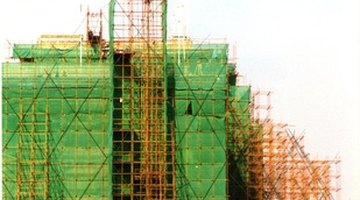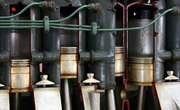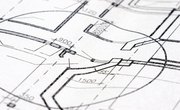The LEED building certification program is an initiative of the U.S. Green Building Council or USGBC. LEED stands for "Leadership in Energy and Environmental Design," and focuses on encouraging a more sustainable approach to the way buildings are designed, constructed and operated. For new construction and major renovations, the LEED program has five main categories in which points toward certification can be earned. Each category also has required prerequisites worth no points. To attain LEED silver certification, a project must earn a total of 50 to 59 points when measured against the latest LEED certification checklist published by the USGBC.
LEED Certification Levels and Benefits
LEED certification levels range from the basic LEED Certified ranking to the higher-ranked LEED Silver, LEED Gold, and finally LEED Platinum certifications, the highest honors offered by the USGBC. A LEED certification lasts five years, after which point the building must be reviewed again to maintain its certification. Builders and owners apply for certification through the USGBC, after which an assessor will tour the building and investigate it to determine whether it passes certification requirements. Various factors can earn a building points, and the total number of points determine whether the building will earn certification. Before a building can earn points however, it must meet the minimum requirements set by the USGBC and comply with the region's environmental laws. Regional laws will vary, but buildings must have a floor area of at least 1,000 feet, exist as a permanent structure, and be no larger than 1500 acres. These requirements encourage builders to minimize environmental impact and ensure that builders cannot circumvent local regulations and still earn the benefits offered by LEED certification. While there are no tax benefits at the federal level for LEED certification (in part because the USGBC is a non-profit organization unrelated to the United States government), many states and counties offer tax, permit, and business benefits to builders and owners of LEED certified buildings to encourage the building and renovation of buildings to fit the standards. At the same time, LEED certification has become valued in certain circles, allowing owners to charge higher rent in certified spaces.
Sustainable Sites – 26 Possible Points
The prerequisite for the Sustainable Sites category aims to curtail pollution and soil erosion that often result from construction. This category also offers points for strategies toward cultivating overall sustainability. For instance, a project wins points for choosing an urban or brownfield site rather than a previously undeveloped area. This category also pertains to the building’s direct environmental impact on the immediate area. This can be connected to not only air pollution, but the way a building design moves rainwater or minimizes light or heat pollution that may affect wildlife in the area through the use of tinted windows and effective insulation.
Water Efficiency – 10 Possible Points
The prerequisite here is for the building to use 20 percent less water than the USGBC baseline for buildings of similar size and occupation. A project garners further points for going substantially beyond this 20 percent reduction in water use, as well as implementing further water conservation measures that pertain to landscaping and wastewater technologies. This can be accomplished through the use of water metering, bathroom and plumbing designs meant to reduce water use, and the addition of water cooling towers. Of particular use to building designs that wish to earn points in this category are drainage gardens and systems that make irrigation systems redundant.
Energy and Atmosphere – 35 Possible Points
This category focuses mainly on building commissioning and the energy performance of main systems such as HVAC and Lighting. It entails three prerequisites: the building must be fundamentally commissioned (commissioning a building is the testing and balancing of the main systems to assure optimum performance), use at least 10 percent less energy than the USGBC baseline, and contain systems that do not use any chlorofluorocarbon (CFC) based refrigerants. Extra points go for progressing further than prerequisite dictates in these areas as well as for the use of renewable energy sources for building operation.
Materials and Resources – 14 Possible Points
This category deals with reuse and recycling of materials, both in the construction and the ongoing operation of the building. Buildings designed to minimize material use, or which use biodegradable or locally harvested renewable resources in their construction process will earn points in this category -- as will buildings designed to operate in ways that minimize landfill waste and promote recycling.
Indoor Environmental Quality – 15 Possible Points
This category deals mainly with indoor air quality issues including ventilation, off-gassing of materials and thermal comfort. It also deals with the need for lighting systems to be energy efficient as well as adequate for all necessary tasks.
Extra Credit – 10 Possible Points
There are two categories with no prerequisites where you can garner extra-credit points: Innovation in Design and Regional Priority. Innovation in Design deals with successful and innovative solutions for environmental and sustainable concerns. Regional Priority focuses on the addressing of region-specific environmental issues. Many LEED Gold and LEED Platinum-ranked buildings earn this certification by paying attention to these bonus categories.
Related Articles
References
Writer Bio
Sean Grimsby was first published in 1974, in "Humpty Dumpty Magazine." In recent years he has worked as a copywriter and ghost writer. Grimbsy is rigorously self-educated with specialization in: cultural anthropology, comparative religion, philosophy, musicology, and Chinese internal arts, in which he's a certified instructor and 25-year practitioner.











